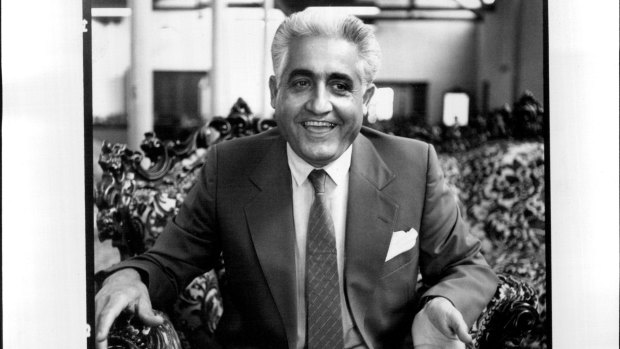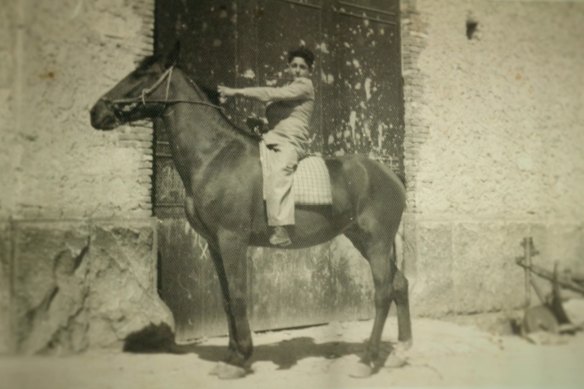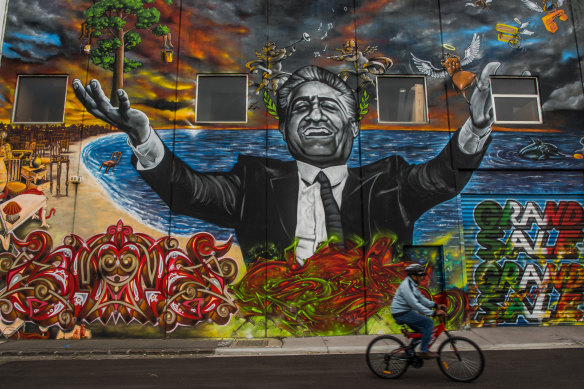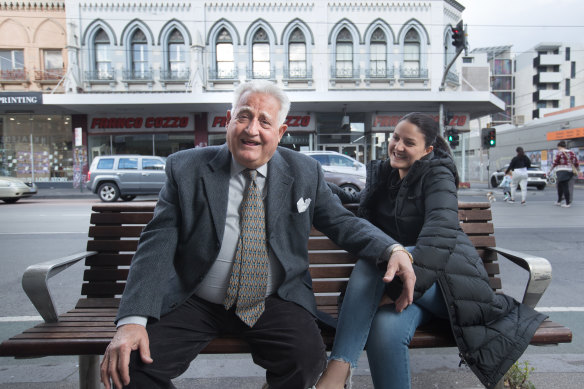By Rachael Dexter and Bianca Hall
He sailed into Port Melbourne on January 26, 1955, after a 32-day journey from Italy, alone and with not a word of English.
Francesco “Franco” Cozzo died on Wednesday, aged 88: a father, husband, grandfather, household name, a migrant success story and a Melbourne legend.

Franco Cozzo first found financial success as a door-to-door salesman before starting his furniture empire.Credit: Ponch Hawkes
Social media and talkback radio lit up after news of his death broke on Wednesday, with Melburnians sharing memories of the gregarious man and the baroque Italian pieces – many now treasured family heirlooms – that furnished the living rooms of their childhood.
The state government says it is too soon to say whether the “king of furniture” would receive a state funeral, but Health Minister Mary-Anne Thomas said he was “a much loved icon [and] a true migrant success story”.
A recent documentary – Palazzo di Cozzo by Melbourne filmmaker Madeleine Martiniello – helped immortalise Cozzo, telling the story of the man behind the catchphrases in full detail.
Born in Ramacca in the province of Catania in Sicily in 1935, Cozzo worked with his horse-trading Greek father. It was a tough life – he didn’t like working up close with the beasts – and in Cozzo’s own words he, “imagined a life more beautiful”.

A young Franco Cozzo in Sicily, where his father worked with horses.Credit: Film ‘Palazzo di Cozzo’
“I want to be [an] artist myself – I wanted to be singer, but I have a very tough daddy. [So] I can’t do that,” he said in the documentary.
Cozzo was devastated after the sudden death of his sister, Vincenzina, at 12 years old, from a heart attack.
Feeling he had little to keep him in Sicily, like thousands of other Italians living in the shadow of World War II, he set sail for Australia, promising his tearful mother he would only be gone three or four years.
He found his first financial success in his 20s as a door-to-door salesman in Melbourne’s inner suburbs, selling whitegoods with rudimentary English.
“I move my hands to speak English,” he told Don Lane, in 1981, adding he had success selling household goods to fellow migrants from Italy, Greece and Malta.

The mural on the Franco Cozzo Footscray building.Credit: Richard Cornish
He soon figured out how to identify the homes of his most likely customers: houses painted white were likely Italian, Maltese homes would be blue, and pink homes were most likely Greek.
The dead giveaways would be tomatoes, basil and other produce growing in the front yard.
With the earnings from this door-to-door grind, he purchased his first store in North Melbourne on the corner of Victoria and Chetwynd Street, selling whitegoods and furniture.
There was a short stint of running a Fiat car dealership, but in Palazzo di Cozzo, he says he got out of the business due to the mafia characters that he said lurked in the industry.
“I don’t want to get a visit from a standover man who will tell me what to do,” he said.
“I prefer to stay with furniture because it is a beautiful business to deal.”
And so he did – eventually growing his empire and opening his iconic emporiums in Brunswick on the corner of Sydney Road and Victoria Street and in Footscray on Hopkins Street.
Cozzo took to television with a natural flair; in the late 1960s he produced Australia’s first non-English speaking music television program Carosello.
Then in the 1980s came the TV ads. When he burst onto the screens with his ebullient promotions spoken in English and Italian – later ads also added Greek – it was groundbreaking.
Australian television during the 1980s and 1990s was a distinctly white-bread affair.
Cozzo’s advertisements were the first time Italian and Greek languages had featured as part of a mainstream advertisement, and were beloved by post-war migrants from Europe and Anglo Australians alike.
Every Melbourne kid from those days can still recite the best-known and longest-running ad released in 1990 (megalo, megalo, megalo). Many, thanks to Cozzo, will always call Footscray “Footiscray”.
Cozzo never did move back to Sicily as his mother wanted, but brought his parents out to Australia in 1962 – and a new Australian branch of the Cozzo family grew. Cozzo was married twice, and had 10 children in all – nine daughters and a son.
Such was his anguish over the death of his sister as a child, Cozzo recalled telling his mother: “One day if I [get] married, I want a soccer team [of children].”
“A lot of children. You know why? Because I was alone in my family,” he said.
In the public eye, Cozzo’s name recognition reached wild heights; there was The Franco Cozzo Song created by Tony Cursio in collaboration with the furniture dealer himself, which opens with the bouncy line,“Hey Franco Cozzo, Drives a lots of people crazy everydays he always on the television!”
For a generation, Cozzo was everywhere. In the 1990s, Cozzo recorded an advertisement for The Age’s classified section.
Accompanying The Age mascot ICPOTA – which stood for In the Classified Pages of The Age – Cozzo said, “He’s so good, believe me. I wish he come and work for me! But he like work for The Age. Mama mia.”
Turning to ICPOTA, he joked, “Listen, I make you an offer which you can’t refuse, eh?”
A passionate Western Bulldogs supporter, his beloved players ran on the field for their Round 7 match against Richmond in 2017 through a banner that said: “We’ve got flair, we’ve got guile, Richmond have IKEA, we have Franco Cozzo style.”
Cozzo was also an enthusiastic and hilarious user of Instagram in 2016 and 2017, though he was less prolific in recent years.
Among his 2016 posts was one of former US president Donald Trump in front of an ostentatious bedroom setting, captioned: Mr. @therealdonaldtrump has great taste in furniture#francocozzo #barocco #venetian #compratedafrancocozzo
There was controversy in the Cozzo empire at its heights, including the 1992 conviction of his son, Luigi, for selling drugs hidden in furniture at the Footscray store.
Cozzo always vehemently denied rumours of his stores being drug fronts and when asked in the film said, “Jealous people can take their abuse somewhere else.”
Drenched in cologne, hair quiffed and always smartly dressed, Cozzo was a dedicated salesman for life. It was all he knew, he said: it was his passion and to some extent his curse.

Franco Cozzo and his daughter Angelina outside his Brunswick store in 2018.Credit: Simon Schluter
The 2022 film showed him struggling to move what remained of $5 million of furniture – the remnants of a time when middle-class families could not get enough of his wares. He held on for years when he could have retired, persisting with his business.
“I didn’t admit to myself that business was stopping. No more furniture is sold,” he said.
Cozzo, who arrived in Melbourne on a ship, described his beloved Footscray store of five decades also as his “ship” after it was sold for $7 million in 2018.
“The ship will depart,” he said in the film, smiling.
“And when the ship is gone ... Franco Cozzo is over. Everything is over. Ciao.”
With Lachlan Abbott
Get the day’s breaking news, entertainment ideas and a long read to enjoy. Sign up to receive our Evening Edition newsletter here.
clarification
An earlier version of this story stated Cozzo was referenced on the Western Bulldogs’ banner for the 2016 grand final against Richmond. The article has been amended to say the banner was for the Western Bulldogs’ round 7 match against Richmond in 2017.